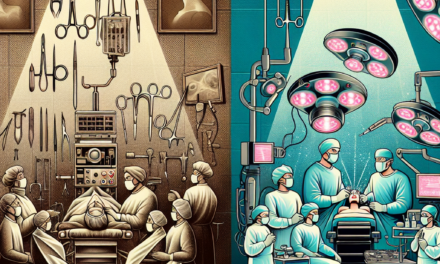Maximizing Cloud Technology in Healthcare

In recent years, cloud technology has revolutionized various industries, and healthcare is no exception. The integration of cloud computing in healthcare has opened new avenues for improving patient care, enhancing operational efficiency, and reducing costs. This article delves into the multifaceted benefits of cloud technology in healthcare, exploring its potential to transform the industry. We will examine five key subtopics, each providing detailed insights into how cloud technology can be maximized in healthcare settings.
1. Enhancing Data Management and Accessibility
Data management is a critical component of healthcare operations. With the increasing volume of patient data, healthcare providers face challenges in storing, managing, and accessing this information efficiently. Cloud technology offers a robust solution to these challenges, providing scalable storage options and facilitating seamless data access.
1.1 Scalable Storage Solutions
One of the primary advantages of cloud technology is its ability to offer scalable storage solutions. Healthcare organizations generate vast amounts of data daily, from patient records to imaging files. Traditional on-premises storage systems often struggle to accommodate this data growth, leading to inefficiencies and increased costs.
Cloud storage solutions, such as Amazon Web Services (AWS) and Microsoft Azure, provide healthcare organizations with the flexibility to scale their storage needs according to demand. This scalability ensures that healthcare providers can store and manage large volumes of data without the need for significant upfront investments in physical infrastructure.
1.2 Improved Data Accessibility
Cloud technology enhances data accessibility by enabling healthcare professionals to access patient information from anywhere, at any time. This capability is particularly beneficial in emergency situations where timely access to patient data can be critical.
For instance, cloud-based electronic health records (EHR) systems allow doctors to access patient histories, lab results, and treatment plans remotely. This accessibility not only improves the quality of care but also facilitates collaboration among healthcare providers, leading to more informed decision-making.
1.3 Data Security and Compliance
Data security is a paramount concern in healthcare, given the sensitive nature of patient information. Cloud technology providers invest heavily in security measures to protect data from breaches and unauthorized access. These measures include encryption, multi-factor authentication, and regular security audits.
Moreover, cloud providers ensure compliance with healthcare regulations such as the Health Insurance Portability and Accountability Act (HIPAA) in the United States. By leveraging cloud technology, healthcare organizations can enhance their data security posture while ensuring compliance with industry standards.
1.4 Case Study: Mayo Clinic
The Mayo Clinic, a renowned healthcare organization, has successfully leveraged cloud technology to enhance its data management capabilities. By migrating its data to the cloud, the Mayo Clinic has improved data accessibility for its healthcare professionals, enabling them to provide better patient care.
The cloud-based system also allows the Mayo Clinic to analyze large datasets, leading to more accurate diagnoses and personalized treatment plans. This case study highlights the transformative potential of cloud technology in healthcare data management.
1.5 Future Trends in Data Management
As cloud technology continues to evolve, new trends are emerging in healthcare data management. One such trend is the integration of artificial intelligence (AI) and machine learning (ML) with cloud-based systems. These technologies can analyze vast amounts of data to identify patterns and predict patient outcomes, further enhancing the quality of care.
Additionally, the adoption of hybrid cloud models is gaining traction in healthcare. These models combine the benefits of public and private clouds, offering healthcare organizations greater flexibility and control over their data.
2. Streamlining Healthcare Operations
Cloud technology plays a pivotal role in streamlining healthcare operations, leading to increased efficiency and reduced costs. By automating routine tasks and optimizing resource allocation, healthcare providers can focus more on patient care and less on administrative burdens.
2.1 Automating Administrative Tasks
Administrative tasks, such as appointment scheduling, billing, and claims processing, can be time-consuming and prone to errors. Cloud-based solutions automate these tasks, reducing the administrative burden on healthcare staff and minimizing the risk of errors.
For example, cloud-based appointment scheduling systems allow patients to book appointments online, reducing the need for manual scheduling. This automation not only improves patient satisfaction but also frees up staff time for more critical tasks.
2.2 Optimizing Resource Allocation
Cloud technology enables healthcare organizations to optimize resource allocation by providing real-time insights into resource utilization. This capability is particularly valuable in hospital settings, where efficient resource management is crucial for delivering quality care.
For instance, cloud-based systems can track the availability of hospital beds, medical equipment, and staff, allowing healthcare providers to allocate resources more effectively. This optimization leads to reduced wait times for patients and improved operational efficiency.
2.3 Enhancing Collaboration and Communication
Effective collaboration and communication are essential for delivering high-quality healthcare. Cloud technology facilitates seamless communication among healthcare providers, enabling them to collaborate more effectively on patient care.
Cloud-based communication platforms, such as Slack and Microsoft Teams, allow healthcare teams to share information and collaborate in real-time. This enhanced communication leads to more coordinated care and better patient outcomes.
2.4 Case Study: Cleveland Clinic
The Cleveland Clinic, a leading healthcare institution, has successfully leveraged cloud technology to streamline its operations. By adopting cloud-based solutions, the Cleveland Clinic has automated various administrative tasks, leading to increased efficiency and reduced costs.
The cloud-based system also enables the Cleveland Clinic to optimize resource allocation, ensuring that patients receive timely and appropriate care. This case study demonstrates the significant impact of cloud technology on healthcare operations.
2.5 Future Trends in Healthcare Operations
As cloud technology continues to advance, new trends are emerging in healthcare operations. One such trend is the use of predictive analytics to optimize resource allocation. By analyzing historical data, healthcare providers can predict future demand for resources and allocate them more effectively.
Additionally, the integration of Internet of Things (IoT) devices with cloud-based systems is gaining traction in healthcare. IoT devices can collect real-time data on patient health and resource utilization, providing valuable insights for optimizing operations.
3. Improving Patient Care and Outcomes
Cloud technology has the potential to significantly improve patient care and outcomes by enabling personalized treatment plans, enhancing patient engagement, and facilitating remote monitoring.
3.1 Personalized Treatment Plans
Cloud technology enables healthcare providers to develop personalized treatment plans based on individual patient data. By analyzing large datasets, healthcare professionals can identify patterns and tailor treatment plans to meet the unique needs of each patient.
For example, cloud-based systems can analyze genetic data to identify patients at risk for certain diseases and develop personalized prevention strategies. This personalized approach leads to more effective treatments and improved patient outcomes.
3.2 Enhancing Patient Engagement
Patient engagement is a critical component of effective healthcare delivery. Cloud technology facilitates patient engagement by providing patients with access to their health information and enabling them to participate actively in their care.
Cloud-based patient portals allow patients to view their medical records, schedule appointments, and communicate with their healthcare providers. This increased engagement leads to better adherence to treatment plans and improved health outcomes.
3.3 Facilitating Remote Monitoring
Remote monitoring is an essential aspect of modern healthcare, particularly for patients with chronic conditions. Cloud technology enables remote monitoring by collecting and analyzing real-time data from wearable devices and other IoT devices.
This capability allows healthcare providers to monitor patients’ health remotely and intervene promptly if any issues arise. Remote monitoring not only improves patient outcomes but also reduces the need for hospital visits, leading to cost savings for both patients and healthcare providers.
3.4 Case Study: Kaiser Permanente
Kaiser Permanente, a leading healthcare organization, has successfully leveraged cloud technology to improve patient care and outcomes. By adopting cloud-based solutions, Kaiser Permanente has developed personalized treatment plans for its patients, leading to more effective care.
The cloud-based system also enables remote monitoring of patients with chronic conditions, allowing healthcare providers to intervene promptly and prevent complications. This case study highlights the transformative impact of cloud technology on patient care.
3.5 Future Trends in Patient Care
As cloud technology continues to evolve, new trends are emerging in patient care. One such trend is the use of AI and ML to develop predictive models for patient outcomes. These models can identify patients at risk for certain conditions and enable early intervention.
Additionally, the integration of virtual reality (VR) and augmented reality (AR) with cloud-based systems is gaining traction in healthcare. These technologies can enhance patient engagement and improve the quality of care by providing immersive experiences for patients.
4. Reducing Costs and Increasing Efficiency
Cloud technology offers significant cost-saving opportunities for healthcare organizations by reducing infrastructure costs, optimizing resource utilization, and improving operational efficiency.
4.1 Reducing Infrastructure Costs
One of the primary benefits of cloud technology is its ability to reduce infrastructure costs. Traditional on-premises systems require significant investments in hardware, software, and maintenance. In contrast, cloud-based solutions eliminate the need for physical infrastructure, leading to cost savings.
Healthcare organizations can leverage cloud technology to reduce their capital expenditures and allocate resources more effectively. This cost reduction allows healthcare providers to invest in other areas, such as patient care and research.
4.2 Optimizing Resource Utilization
Cloud technology enables healthcare organizations to optimize resource utilization by providing real-time insights into resource availability and demand. This capability allows healthcare providers to allocate resources more effectively, leading to increased efficiency and reduced costs.
For example, cloud-based systems can track the availability of hospital beds, medical equipment, and staff, allowing healthcare providers to allocate resources more effectively. This optimization leads to reduced wait times for patients and improved operational efficiency.
4.3 Improving Operational Efficiency
Cloud technology improves operational efficiency by automating routine tasks and streamlining workflows. By reducing the administrative burden on healthcare staff, cloud-based solutions allow healthcare providers to focus more on patient care and less on administrative tasks.
For instance, cloud-based appointment scheduling systems allow patients to book appointments online, reducing the need for manual scheduling. This automation not only improves patient satisfaction but also frees up staff time for more critical tasks.
4.4 Case Study: Intermountain Healthcare
Intermountain Healthcare, a leading healthcare organization, has successfully leveraged cloud technology to reduce costs and increase efficiency. By adopting cloud-based solutions, Intermountain Healthcare has reduced its infrastructure costs and optimized resource utilization.
The cloud-based system also improves operational efficiency by automating routine tasks and streamlining workflows. This case study demonstrates the significant impact of cloud technology on healthcare costs and efficiency.
4.5 Future Trends in Cost Reduction
As cloud technology continues to advance, new trends are emerging in cost reduction. One such trend is the use of AI and ML to optimize resource utilization and reduce costs. These technologies can analyze historical data to predict future demand for resources and allocate them more effectively.
Additionally, the adoption of hybrid cloud models is gaining traction in healthcare. These models combine the benefits of public and private clouds, offering healthcare organizations greater flexibility and control over their data while reducing costs.
5. Facilitating Research and Innovation
Cloud technology plays a crucial role in facilitating research and innovation in healthcare by providing researchers with access to vast amounts of data and enabling collaboration among researchers worldwide.
5.1 Access to Vast Amounts of Data
Cloud technology provides researchers with access to vast amounts of data, enabling them to conduct large-scale studies and develop new treatments and therapies. This access to data is particularly valuable in fields such as genomics and personalized medicine.
For example, cloud-based platforms such as Google Cloud’s Genomics API allow researchers to analyze large genomic datasets and identify genetic markers associated with diseases. This capability accelerates the pace of research and leads to new discoveries.
5.2 Enabling Collaboration Among Researchers
Cloud technology facilitates collaboration among researchers worldwide by providing a platform for sharing data and resources. This collaboration is essential for advancing research and developing new treatments and therapies.
Cloud-based collaboration platforms, such as Google Workspace and Microsoft 365, allow researchers to share data and collaborate in real-time. This enhanced collaboration leads to more coordinated research efforts and faster progress.
5.3 Accelerating Drug Development
Cloud technology accelerates drug development by providing researchers with access to powerful computing resources and advanced analytics tools. These capabilities enable researchers to analyze large datasets and identify potential drug candidates more quickly.
For instance, cloud-based platforms such as AWS’s Drug Discovery Platform provide researchers with access to machine learning algorithms and computational chemistry tools, enabling them to accelerate the drug discovery process.
5.4 Case Study: The Human Genome Project
The Human Genome Project, a landmark research initiative, successfully leveraged cloud technology to map the human genome. By utilizing cloud-based platforms, researchers were able to analyze vast amounts of genomic data and complete the project ahead of schedule.
The success of the Human Genome Project highlights the transformative impact of cloud technology on research and innovation in healthcare.
5.5 Future Trends in Research and Innovation
As cloud technology continues to evolve, new trends are emerging in research and innovation. One such trend is the use of AI and ML to analyze large datasets and identify new drug candidates. These technologies can accelerate the drug discovery process and lead to new treatments and therapies.
Additionally, the integration of blockchain technology with cloud-based systems is gaining traction in healthcare research. Blockchain can enhance data security and enable researchers to share data more securely, facilitating collaboration and innovation.
Conclusion
Cloud technology has the potential to transform the healthcare industry by enhancing data management, streamlining operations, improving patient care, reducing costs, and facilitating research and innovation. By leveraging cloud-based solutions, healthcare organizations can improve the quality of care, increase efficiency, and drive innovation.
As cloud technology continues to evolve, new trends and opportunities will emerge, further enhancing its impact on healthcare. By staying abreast of these developments and adopting cloud-based solutions, healthcare organizations can maximize the benefits of cloud technology and deliver better care to their patients.





